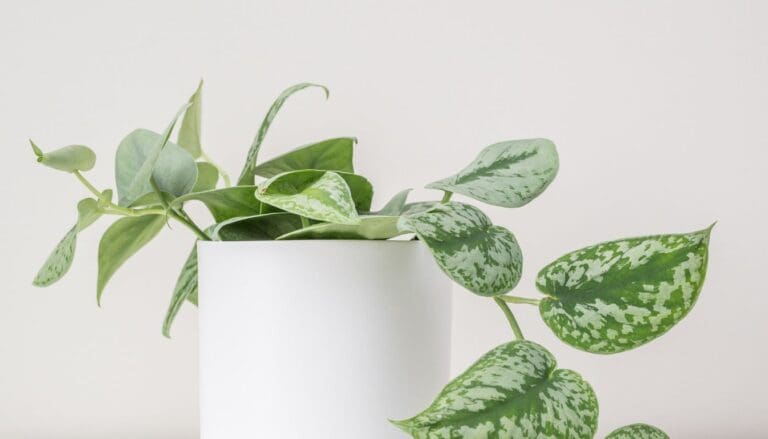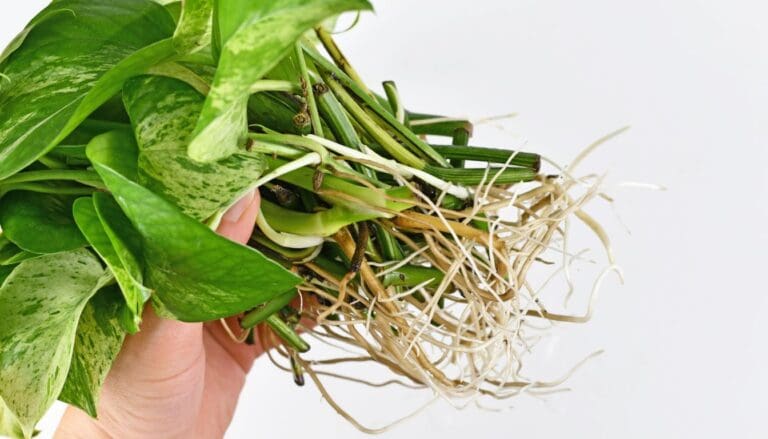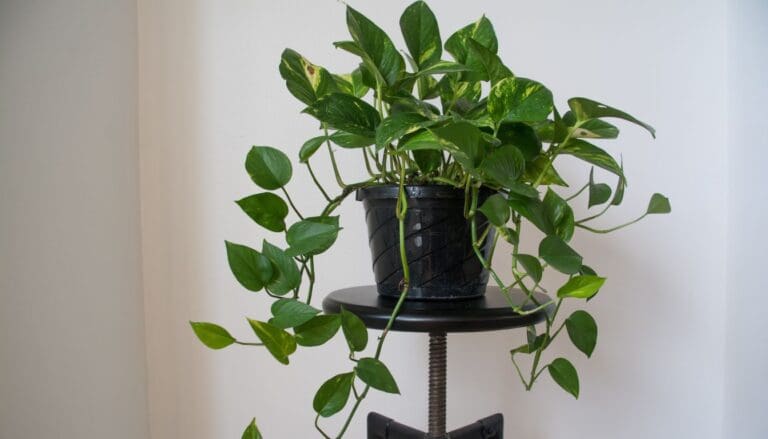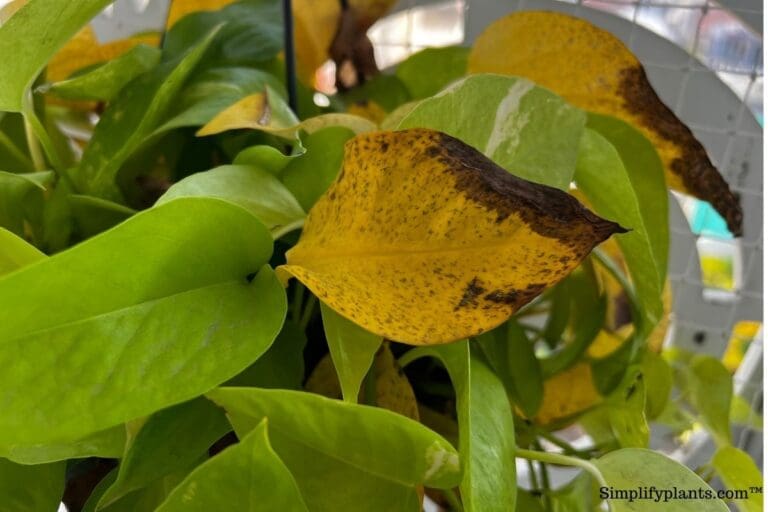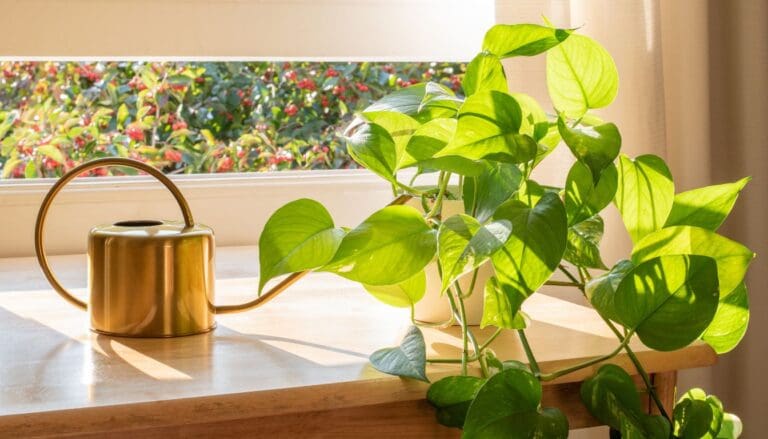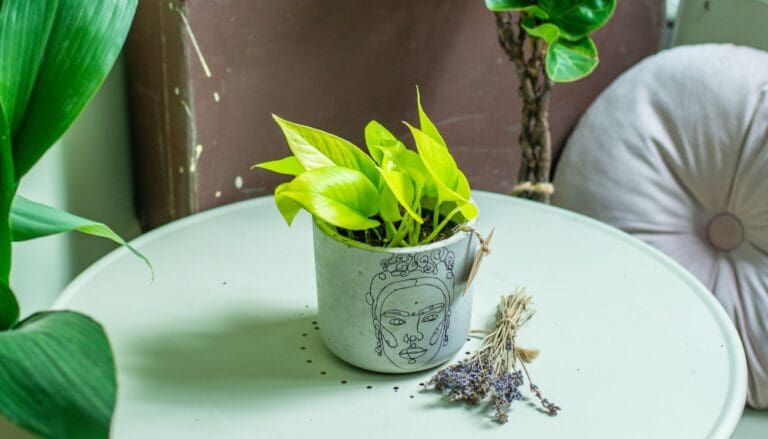7 Causes Of Holes In Pothos Leaves (+How To Fix It)
Pothos is a favorite amongst all houseplant owners due to its low-demanding nature and ability to survive in various conditions. One of the few problems this plant goes through is the development of holes in the leaves, which can ruin its aesthetics and health.
Some common reasons for holes in the leaves of your pothos plant are bacterial infections, snails, leaf miners, fungal diseases, accidental injury, insects, etc. To fix the holes in the leaves of your pothos plant, determine the correct causes and take the necessary steps to resolve the issue.
If you have recently spotted holes in your beautiful pothos, fret not. This article will guide you with the causes that might have resulted in them and suggest ways to cure the plant.

Please note: Simplify Plants is reader-supported. Some links in the post are affiliate links and I get a commission from purchases made through links in the post.
Why are there holes in my pothos plant?
Pothos is a bushy evergreen plant that comes in green and variegated colors.
They are known by names like money plant, devil’s ivy, etc.
Hands down, they are the most popular houseplant around the world.
But holes in the leaves are one problem you might notice.
Holes on the pothos leaves can appear for multiple reasons, which I have briefly mentioned above.
Now I will talk about them elaborately below.
1. Leaf mining flies
Leaf-mining flies are one of the most common reasons that lead to holes in the surface of the leaves.
These bugs, known as Liriomyza Melanogaster, attack plants during the night and create tunnels in the tissues of the leaves and feed on them.
One of the best signs of their presence is the appearance of half-eaten leaves.
These bugs feed on the leaves incessantly, and as a result, multiple holes appear in your healthy plants.
If these bugs remain unnoticed for a long time, they can put a lot of stress on your plants.
As a result of that, the plant may stop growing.
Even worse, these bugs are contagious and, if not treated quickly, can spread to other plants quickly and infect them too.
2. Other bugs

There are some other bugs that infest pothos plants and make holes in the leaves, like:
- Mealybugs: Indoor plants are commonly attacked by mealybugs, which attach themselves to the leaves and suck their nutrients. You can easily remove them by applying a Neem oil solution.
- Snails and slugs: They chew the pothos leaves and leave a silver trail where they have attacked.
- Caterpillars: These are the larvae of butterflies and moths and feed on the soft leaves and lay their eggs on the plant. Mostly they attack outdoor plants, but sometimes they invade your houseplants too.
3. Diseases
Many bacterial and fungal diseases can occur in your pothos which will cause unsightly holes in the leaves.
Leaf spot and shot hole diseases are two of the most common culprits that create holes in the leaves.
- Bacterial leaf spot disease starts on the leaves as tiny, harmless holes that we most often ignore. But over time, these spots spread to the other leaves and gradually develop into holes. When you first notice these signs, it is best to burn the leaves as they spread quickly to other plants.
- Shot hole disease starts as red or purple spots on the leaves, and as they get darker, they begin to resemble gunshots which gives it the name. One of the common causes of this disease is keeping the soil of plants wet for a long time. So it is important to always let the topsoil dry before watering again.
4. Accidental damage
There can be accidental damage to the plant that also causes holes in the leaves of the pothos.
Sometimes constant moving of the plant from one spot to another, wear and tear with the foliage, or playing around with them can accidentally injure the leaves.
When the young leaves get damaged, they develop holes in them as they mature.
5. Too much fertilizer

Fertilizers are one of the crucial parts of healthy and strong plants.
In the case of indoor plants, it’s all the way more important, as potted plants tend to lose the nutrients in the soil over time with regular watering and leaching.
So adding extra nutrients to the soil through fertilizers is very important.
However, one common mistake is overfertilizing our plants which causes more harm than good.
Overfertilization leads to the accumulation of minerals and salts in the soil that starts to build up and burns the plant if not checked.
Too much feeding also results in the rapid growth of the pothos sometimes.
This pushes the leaves to open too quickly, which causes them to develop small holes or cracks under pressure.
6. Exposure to direct sunlight
Pothos, or money plants, are native to the tropical parts of the world where they grow in rainforests, under the canopy of larger trees that keep these plants under shade.
Pothos, therefore, grow in dappled sunlight, which they receive under the bigger trees; therefore, they cannot tolerate direct hot sunlight on them.
You need to place your pothos in your homes where they get indirect bright light.
Direct sunlight in hot summers can quickly scorch the foliage of your pothos.
The sunburnt pothos develops brown spots on them, which progress into small holes in the leaves.
So if you want to keep your pothos at the sunny window or patio, you need to make sure that they are not directly under the sunlight and that you put a filter to diffuse the light intensity.
7. Poor humidity

One of the main environmental concerns that can lead to holes in the leaves is the lack of required humidity levels.
When the humidity levels stay low, the leaves get crispier due to dehydration and water loss.
This destroys the elasticity of the leaves and, in the process, can get damaged and develop holes in them.
How to treat the holes in the leaves?
Luckily for the pothos owners, you can treat the condition with patience and effort.
Though the leaves that are already infested will not heal, the new leaves will grow fresh and healthy if you follow the right treatment.
So now that we have discussed the causes of the problem, we will discuss the treatments.
1. Neem oil
Neem oil is the best organic option to cure all the pests and bugs from houseplants.
Neem oil can treat leaf mining bugs effectively.
They are free of chemicals and toxicity and fully natural.
Mix one tablespoon of neem oil in 1 liter of water and spray judiciously on your pothos, focusing on all the leaves and their undersides where the bugs mostly crawl.
You must use this spray 3-4 days a week to find results.
2. Insecticidal soap
Insecticidal soaps are also another safe option to eliminate the bugs or insects on the plant.
Mix them with water, spray them all over, and let the leaves marinate.
Repeat the application for a few days to see the result.
3. Prune the damaged leaves

The leaves that the holes have already damaged will not return to their original form.
Keeping those leaves attached will only make the plant waste energy on keeping them alive.
By trimming them off, you save that energy, and instead, the plant gets to use it to produce new and fresh leaves.
However, before trimming them, remember to sterilize the shears with rubbing alcohol so that they are free of any germ that can contaminate the pothos.
Also, you should never prune more than 25% of a plant at a time so that it can carry on with its everyday activities like evaporation, transpiration, etc.
If you find the plant has been heavily infested with bugs, it is best to repot the plant in fresh soil after pruning the infested leaves.
To repot the plant, follow the below steps:
- Take the plant outside the pot carefully.
- Wash it under running water.
- Inspect the plant thoroughly for signs of bugs.
- Examine the roots. Healthy roots should be white and crisp.
- Take a fresh pot with a drainage hole and prepare a soil mix.
- Pothos plant thrives best in well-draining soil that can retain moisture.
- Mix soil with perlite, peat moss, and sand to create perfect soil for the plants.
- Repot the plant in the new soil.
- Water it until it runs out of the drainage holes, then do not water it again until the soil is dry.
- Keep it in a spot with a lot of bright light and good airflow.
4. Apple cider vinegar solution
This is a natural fungicide.
Prepare a natural mixture of apple cider vinegar with five parts water and wipe the leaves of your pothos with it once every month to repel all bugs.
5. Copper or sulfar fungicide
Most kinds of fungal diseases in houseplants can be treated by sulfur and copper fungicides sprayed on the pothos directly.
6. Avoid damage

As discussed above, sometimes, we unknowingly damage plants by playing around with them or frequently moving them.
It is important to know that plants, like humans, do not like getting disturbed too much.
It can tear and affect the leaves by creating holes or cracks.
It also puts unwanted stress on the plants because moving them too frequently from one spot to the other puts the plant under stress.
It has to put a lot of energy into adjusting to new surroundings, so the plant gets under trauma, affecting its growth and health.
Also, in homes with pets and children, you must be careful where you place your pothos.
Pothos contain insoluble calcium oxalate crystals, which can be harmful if ingested.
They are like crystals that, if ingested, can tear tissues in the mouth and digestive tract.
Furthermore, children and pets have a habit of playing around with plants which can also damage the plant and develop holes or damage on the leaves.
Keep your pothos healthy

Easy ways to keep your pothos free from damage and holes and ensure they are healthy:
1. Increase humidity
Pothos enjoy humid environments because they are native to the rainforests where the environment is humid.
Pothos plants enjoy being misted but remember to always mist in the early morning so the plant does not stay wet after sunset, which can invite pests and fungus.
You can also use a pebble tray method or a humidifier which is a device to increase humidity in a room.
2. Maintain proper temperatures
Pothos plants need warm temperatures, ideally ranging between 70-90°F.
If the temperature goes below 50°F, you must protect them from cold damage and injury.
If you live in a very cold area, these plants are not tolerant of frost, so ensure you keep your pothos warm.
Keep the plant away from cold drafts, glass panes, or windy areas with frequent temperature fluctuations.
Also, do not keep them near fireplaces or heaters to keep them warm, as they tend to suck the moisture out of the plant and dehydrate them more.
3. Avoid overwatering
Overwatering is the most common cause of the death of houseplants.
Though pothos like slightly moist soil, remember it is not the same as soggy soil.
Overwatering leads to soil saturated with water which cuts off the oxygen supply and leads to root rot and fungus growth in the soil.
If you need help determining when to water your pothos, use a moisture meter to know the water content in the soil.
Water only when the soil is dry.
4. Use the right soil mix

Remember, the correct soil type is crucial for your houseplants.
Pothos like light, well-draining soil, soil that lets air flow through it and retain some moisture.
If the soil is too clayey and tight, the roots suffocate, resulting in diseases.
So use soil with a pH level of 6.1-6.5, rich in organic matter, loose and airy.
Adding organic elements like compost, orchid bark, perlite, and coco coir helps to increase aeration in the soil and improve texture.
5. Use pots with drainage holes
Using growing pots that have drain holes at the bottom is very important.
The holes let the excess water flow out without them; they remain inside the pot keeping the soil wet and soggy, causing root rot.
6. Fertilize on time
Fertilizer is important because the potting soil loses its nutrients and richness over time.
Fertilizer helps to deliver essential nutrients like magnesium, iron, phosphorous, potassium, calcium, nitrogen, and zinc to the plant.
You can use homemade organic fertilizers like green tea, coffee grounds, compost, eggshells, etc., or synthetic commercial fertilizers.
If you use the latter, make sure you read the instruction of the dosage before using it, as they are highly concentrated and can burn the plants.
7. Ventilation
Make sure you keep the plant in a spot with good light and ventilation.
Pests and bugs attack soil that grows in poorly lit and ventilated areas.
Final words
Pothos are strong, resistant plants that are adaptable to various situations. But still, you need to ensure that the plant gets all the basic care so that infections, pests, and bugs do not invade your pothos and make holes.
If you find holes in your pothos, inspect it thoroughly and try to find the exact cause. Use Neem oil if you find pests, fungicides in case of fungal diseases, and the right care if some condition is unsuitable.
Sources: Study of Pest in Pothos, University of Florida Research, Effects of Different Pot Mixtures on Pothos, Pothos water need a study
Recommended Garden Supplies
| Product Image | Our Recommended Gardening Supplies | Check Offers! |
|---|---|---|
Top Top
Top
Top
Top
Top
Top
Top
Top | rePotme Houseplant and Tropical Classic Potting Soil Mix | Check Offer On Amazon |
 Top
Top
Top
Top
Top
Top
Top
Top | Espoma Organic Indoor Plant Food | Check Offer On Amazon |
 Top
Top
Top
Top
Top
Top
Top
Top | GooingTop LED Grow Light 6000K Full Spectrum Clip Plant Growing Lamp | Check Offer On Amazon |
 Top
Top
Top
Top
Top
Top
Top
Top | Soil Moisture Meter | Check Offer On Amazon |
 Top
Top
Top
Top
Top
Top
Top
Top | Govee Hygrometer Thermometer, Bluetooth Enabled! | Check Offer On Amazon |
 Top
Top | LEVOIT Humidifiers for Large Room(Best For Plants) | Check Offer On Amazon |
 Top
Top
Top
Top
Top
Top
Top
Top | Upgraded DIY Automatic Drip Irrigation Kit, 15 Potted Houseplants Support | Check Offer On Amazon |
 Top
Top
Top
Top
Top
Top
Top
Top | Stainless Steel Heavy Duty Gardening Tool Set | Check Offer On Amazon |
 Top
Top
Top
Top
Top
Top
Top
Top | Bonide Insecticidal Soap | Check Offer On Amazon |
 Top
Top
Top
Top
Top
Top
Top
Top | Bonide 32 oz Spray Neem Oil for Organic Gardening | Check Offer On Amazon |
 Top
Top
Top
Top
Top
Top
Top
Top | Garden Safe Fungicide | Check Offer On Amazon |

